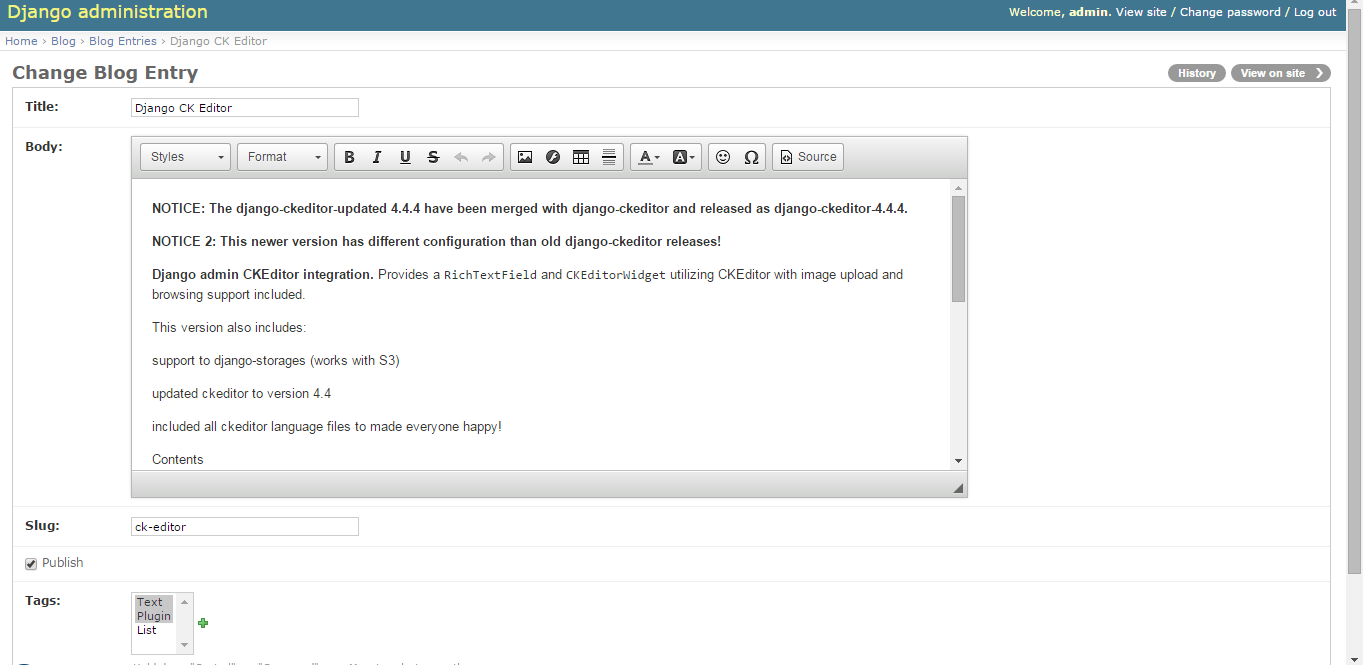Django Markdown编辑器没有出现
我正在创建我的第一个Django应用程序(我也是Python的新手,所以问题可能出现在任何地方)。
我将一步一步地学习本教程,以获得5:53 (这里)的HTML编辑器,但是我仍然在http://127.0.0.1:8000/admin/blog/entry/add/获得默认的TextField
对诊断问题的任何帮助都将不胜感激。谢谢!
我的档案:
项目/qblog/blog/admin.py :
from django.contrib import admin
from . import models
from django_markdown.admin import MarkdownModelAdmin
class EntryAdmin(MarkdownModelAdmin):
list_display = ("title" , "created")
prepopulated_fields = {"slug" : ("title", )}
admin.site.register(models.Entry, EntryAdmin)项目/qblog/qblog/urls.py :
from django.conf.urls import patterns, include, url
from django.contrib import admin
urlpatterns = patterns(
'',
url(r'^admin/', include(admin.site.urls)),
url(r'^markdown/', include("django_markdown.urls")),
)项目/qblog/blog/Models.py :
from django.db import models
# Create your models here.
class EntryQuerySet(models.QuerySet):
def published(self):
return self.filter(publish=True)
class Entry(models.Model):
title=models.CharField(max_length=200)
body = models.TextField()
slug = models.SlugField(max_length=200,unique = True)
publish = models.BooleanField(default=True)
created = models.DateTimeField(auto_now_add = True)
modified = models.DateTimeField(auto_now = True)
objects = EntryQuerySet.as_manager()
def __str__(self):
return self.title
class Meta:
verbose_name = "Blog Entry"
verbose_name_plural = "Blog Entries"
ordering = ["-created"]projects/qblog/qblog/settings.py :
"""
Django settings for qblog project.
Generated by 'django-admin startproject' using Django 1.9.dev20150210173028.
For more information on this file, see
https://docs.djangoproject.com/en/dev/topics/settings/
For the full list of settings and their values, see
https://docs.djangoproject.com/en/dev/ref/settings/
"""
import os
# Build paths inside the project like this: os.path.join(BASE_DIR, ...)
BASE_DIR = os.path.dirname(os.path.dirname(os.path.abspath(__file__)))
# Quick-start development settings - unsuitable for production
# See https://docs.djangoproject.com/en/dev/howto/deployment/checklist/
# SECURITY WARNING: keep the secret key used in production secret!
SECRET_KEY = 'secretkey'
# SECURITY WARNING: don't run with debug turned on in production!
DEBUG = True
TEMPLATE_DEBUG = True
ALLOWED_HOSTS = []
# Application definition
INSTALLED_APPS = [
'django.contrib.admin',
'django.contrib.auth',
'django.contrib.contenttypes',
'django.contrib.sessions',
'django.contrib.messages',
'django.contrib.staticfiles',
'blog',
'django_markdown',
]
MIDDLEWARE_CLASSES = [
'django.contrib.sessions.middleware.SessionMiddleware',
'django.middleware.common.CommonMiddleware',
'django.middleware.csrf.CsrfViewMiddleware',
'django.contrib.auth.middleware.AuthenticationMiddleware',
'django.contrib.auth.middleware.SessionAuthenticationMiddleware',
'django.contrib.messages.middleware.MessageMiddleware',
'django.middleware.clickjacking.XFrameOptionsMiddleware',
'django.middleware.security.SecurityMiddleware',
]
ROOT_URLCONF = 'qblog.urls'
TEMPLATES = [
{
'BACKEND': 'django.template.backends.django.DjangoTemplates',
'DIRS': [],
'APP_DIRS': True,
'OPTIONS': {
'context_processors': [
'django.template.context_processors.debug',
'django.template.context_processors.request',
'django.contrib.auth.context_processors.auth',
'django.contrib.messages.context_processors.messages',
],
},
},
]
WSGI_APPLICATION = 'qblog.wsgi.application'
# Database
# https://docs.djangoproject.com/en/dev/ref/settings/#databases
DATABASES = {
'default': {
'ENGINE': 'django.db.backends.sqlite3',
'NAME': os.path.join(BASE_DIR, 'db.sqlite3'),
}
}
# Internationalization
# https://docs.djangoproject.com/en/dev/topics/i18n/
LANGUAGE_CODE = 'en-us'
TIME_ZONE = 'UTC'
USE_I18N = True
USE_L10N = True
USE_TZ = True
# Static files (CSS, JavaScript, Images)
# https://docs.djangoproject.com/en/dev/howto/static-files/
STATIC_URL = '/static/'回答 6
Stack Overflow用户
发布于 2015-02-10 20:03:17
在视频的评论中,你可以得到答案。修改下一个文件:
models.py
from django_markdown.models import MarkdownField
...
body = MarkdownField()settings.py
...
# Static files (CSS, JavaScript, Images)
# https://docs.djangoproject.com/en/1.7/howto/static-files/
STATIC_URL = '/static/'
STATIC_ROOT = os.path.join(BASE_DIR, "static")
# Markdown
MARKDOWN_EDITOR_SKIN = 'simple'urls.py
...
from yourapp import settings
if settings.DEBUG:
from django.conf.urls.static import static
urlpatterns += static(settings.STATIC_URL, document_root=settings.STATIC_ROOT)shell运行中的:
python manage.py collectstaticStack Overflow用户
发布于 2015-04-28 08:37:34
我也有同样的问题。但是,在运行之后,当我在没有urls.py部分的情况下添加part 1460的代码时:
python manage.py collectstatic,django_markdown可以工作,我使用python2.7和django 1.8版本
这里的urls.py代码
from django.conf.urls import include, url
from django.contrib import admin
#import settings
#if settings.DEBUG:
#from django.conf.urls.static import static
#urlpatterns += static(settings.STATIC_URL,document_root=settings.STATIC_ROOT)
urlpatterns = [
# Examples:
# url(r'^$', 'cblog.views.home', name='home'),
# url(r'^blog/', include('blog.urls')),
url(r'^admin/', include(admin.site.urls)),
url(r'^markdown/', include("django_markdown.urls")),
url(r'^',include('blog.urls')),]
这是我的项目文件,我的项目名是cblog,应用程序是blog:
djtest/cblog/cblog:
__init__.py __init__.pyc settings.py settings.pyc urls.py urls.pyc wsgi.py wsgi.pycdjtest/cblog:
blog cblog db.sqlite3 manage.py staticStack Overflow用户
发布于 2015-05-02 13:00:47
是的,当我尝试qblog教程时,我也发现了这个问题。我使用Python3.4和Django 1.8.1,但是在安装标记包的步骤中,我决定将包更改为Django CKEditor。
访问https://pypi.python.org/pypi/django-ckeditor安装。
在正确安装CKEditor之后,如果您在运行服务器时发现导入forms.util扁平化存在问题。在ckeditor文件夹下更改您的widgets.py (在windows环境中,目录位于C:\Python34 34\Lib\site-packages\ckeditor下),然后更改行:
从django.forms.util进口平板
至
从django.forms.utils进口平板
接下来介绍如何使用CKEditor,然后在qblog上实现它。结果如下:

https://stackoverflow.com/questions/28440383
复制相似问题

